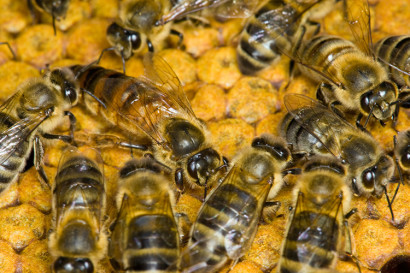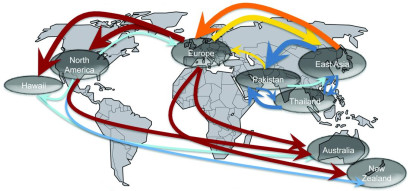Worldwide bee epidemic linked to human cause: colony trafficking
Deformed wing virus spread by global movement of European bee colonies
February 10, 2016
Just as world travel is contributing to the Zika virus epidemic spreading through Latin America and into North America, so too is world traffic in bee colonies fueling a worldwide bee epidemic.

The European honeybee, Apis mellifera, is used worldwide to pollinate crops, but pollution and disease, including a recent epidemic caused by the deformed wing virus, are killing millions annually. iStock photo.
The finding comes from a study by UC Berkeley and Exeter University biologists of the spread of the deformed wing virus, which is affecting European honeybee colonies around the planet as well as wild bee populations. The pandemic is adding to fears over the future of global bee populations, with major implications for biodiversity, agricultural biosecurity, global economies and human health.
While not a threat to human health, the bee epidemic does threaten an important contributor to our food supply. By one estimate, 75 percent of all food crops in the U.S. benefit from pollination, and for commercial crops, that means the European honeybee. The disease is one of many threats to bee populations around the world, usually lumped together as colony collapse disorder.
The virus becomes a problem when carried by the Varroa mite that infests many European honeybees, Apis mellifera. To determine the course and source of the virus’s spread around the globe, a UC Berkeley researcher Michael Boots, professor of integrative biology, collaborated with colleagues at Exeter University in the UK to analyze the genomes of viruses collected from around Europe, Asia, Australia and North America.
They determined that most of the viruses can be traced to European honeybee colonies. The finding suggests that the pandemic is manmade rather than naturally occurring, with human trade and transportation of bees for crop pollination driving the spread. The main spreaders are colony traders in Europe and North America, the researchers found.

The spread of the deformed wing virus over the past 80 years, from Asian bees into European honeybee colonies, and then around the world.
“The key insight of our work is that the global virus pandemic in honeybees is manmade not natural,” said Boots, the senior author of the paper. “It’s therefore within our hands to mitigate this and future disease problems.”
To reduce the negative effects of the deformed wing virus on beekeeping and wild pollinators, the researchers urge tighter controls, such as the imposition of mandatory health screenings and regulated movement of honeybees across borders, with every effort made to maintain the current Varroa-free refugia for the conservation of wild and managed pollinators.
“We must now maintain strict limits on the movement of bees, whether they are known to carry Varroa or not,” said lead author Lena Wilfert of the University of Exeter’s Center for Ecology and Conservation on the Penryn Campus in Cornwall. “It’s also really important that beekeepers at all levels take steps to control Varroa in their hives, as this viral disease can also affect wild pollinators.”
For more about the research, see Exeter University’s news story.